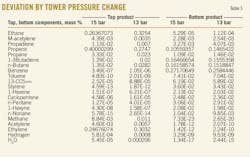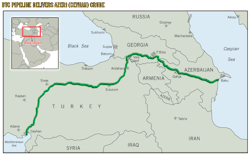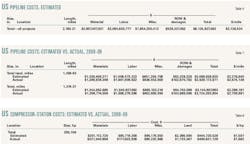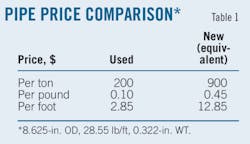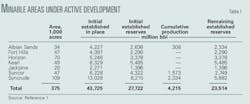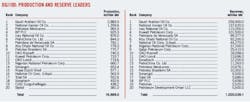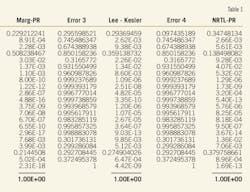Drilling wells through the ultrathick, salt-gypsum beds in the pre-Caspian basin requires an optimized drilling fluid.
The fluid must effectively inhibit salt-gypsum creep, salt dissolution, and hydration expansion in the water-sensitive formation to keep the borehole stable under high pressure and high temperatures.
Pre-Caspian basin
The pre-Caspian basin has the most promising onshore deep oil and gas bearing zones in the former Soviet Union. Also it is already one of the world's most important oil producing areas.
A large portion of the basin lies in the southern part of Kazakhstan, and the rest is in Russia. The basin, with a total area of 50,104 sq km (1,000 km from east to west and 500 km from north to south), is north of the Caspian Sea.
The basin has widely spread, ultrathick, salt-gypsum beds in the Sagiski, Federovskoye, Adaiski, Ural-Volga, and Kolzhan-Uyaly blocks (Fig. 1)and well developed salt dome structures. There are more than 1,500 salt domes, covering 25-30% of the basin's area.
Salt beds are mainly in the Permian Konggu formation, Lower Konggu stage. These beds have thickness of several hundreds meters along the basin boundary and up to 5,000 m inside the depression (Fig. 2).
Salt beds consist of salt rock and karstenite (anhydrite). In the basin boundary, the beds contain gypsum, limestone, dolomite, and shale.
Drilling salt
The major technical difficulties encountered in drilling salt beds in the pre-Caspian basin are:
• Drilling of the thick salt beds, 2,000-4,000 m, can lead to plastic flow of the salt, which threatens drilling safety.
• Salt beds mingled with karstenite dissolve while the gypsum in the beds expands and collapses after absorbing water. This contaminates drilling fluid and causes such incidents as borehole-shrinkage induced pipe sticking, borehole-collapse induced pipe sticking, and casing collapse.
• Salt beds contain much karstenite and mudstone. Balancing the creeping of the salt-gypsum bed requires a high-density drilling fluid. This, however, can easily cause fluid loss to weaker formations such as salt beds and its interlayers.
• The rock salt has high purity, containing 97% salt (Fig. 3). Compared with compound and relatively weak salt beds, it creeps more rapidly. This calls for the use of more advanced drilling fluid.
Before 1990, two peripheral, 37 exploration, and three exploitation and assessment wells were successively drilled in Kenkyak oil field.
Statistics of 36 wells show that borehole collapse, borehole shrinkage, and severe pipe sticking occurred in 13 wells (36%). The problems occurred mostly in salt beds and sometimes led to not reaching drilling targets in the middle Carboniferous Period.
Drilling fluid density
The traditional design approach for determining drilling fluid density for salt beds is based on the drilling fluid column pressure and the nonlinear viscoelastic deformation characteristics of salt rocks. The design includes an analysis of the borehole shrinkage rate under different liquid heads.
Proper drilling fluid density is then determined from the on site borehole shrinkage rate required for safe drilling. This method includes creep parameters measured in the laboratory and complicated shrinkage-rate calculations of salt rocks.
Analysis of borehole well rock deformation properties in deep salt beds requires an understanding of the short-term mechanical behavior of salt rock because such behavior determines the mechanisms for long-term rock deformation.
One can use the acoustic emission signal produced in a salt-rock triaxial compression test (Fig. 4) to determine the relationship between acoustic emission and inner damage of rock to provide a damage-expansion boundary curve of salt rock in an octahedron stress space (Fig. 5). This is also the shear yield strength along the crystal grain boundary in the salt rock.2
Equation 1 in the equation box calculates the maximum octahedron shear stress in a deep, ultra thick, salt-rock formation.3 In the equation, ρo is the salt-rock density and ρw is the wellbore hydrostatic pressure.
If the borehole drilling-fluid head is less than the salt-bed ground stress, salt rock will creep toward the borehole. With an increase in both formation temperature and the differential between salt-rock ground stress and fluid head, borehole shrinkage rate also increases.
Under conditions of relatively high average ground stress, when octahedron shear stress is within the damage-expansion boundary curve, the salt-rock volume remains the same or increases slowly. Only when the octahedron shear stress is outside the damage-expansion boundary curve, the salt-rock volume will increase rapidly due to expansion.
On this basis, we propose the hypothesis that one can guarantee safe drilling if expansion deformation in a salt-bed borehole is zero. In other words, the maximum octahedron shear stress must be within the damage-expansion boundary curve (Equation 2). In the equation τod is the boundary value between compression and damage and τod = 11.92 MPa.3
Equation 3 calculates a safe drilling fluid density ρw.
Calculations of drilling fluid density (Fig. 6) and borehole shrinkage velocity (Fig. 7) show that, even with no expansion in the borehole enclosing rock, shrinkage velocity increases gradually with depth. For instance, when at 5,000-m, borehole shrinkage velocity is 0.0912 mm/hr and the shrinkage rate is 0.00084/hr.
Based on field experience, one can guarantee safe drilling if the shrinkage rate is within 0.1%/hr.
When one maintains the borehole enclosing rock stress state within the damage-expansion boundary curve, no drilling incidences will occur.
Fluid characteristics
When the thickness of salt beds is greater than 500 m, particularly when it is 1,000-4,000 m, one can use a medium-high density, saturated-brine drilling fluid to balance salt bed creep such as in well SLK3 in the Central Asia block and salt wells in the Sagiski block.
A proper high-density drilling fluid in a salt-gypsum bed should have the following characteristics:
• Effective inhibition of salt-gypsum bed creep, salt dissolution, and hydration expansion in the water-sensitive formation to keep the borehole stable.
• Excellent rheological behavior under high temperature.
• Excellent salt resistance, calcium resistance, and drill cutting ejection resistance, as well as excellent lubricity and saline recrystallization resistance.
• Relatively low filtration under high temperatures and high pressures, as well as an ability to form thin and tough mud cake with good compressibility.
Optimized fluid
It is difficult to adjust and control the rheological behavior of high-density drilling fluid. Excessive amounts of bentonite can cause difficulty in controlling viscosity, while inadequate amounts can lead to higher maintenance cost and worsen the degradation of the drilling fluid.
Our laboratory tests show that proper bentonite content is 25-40 g/l. This can guarantee an appropriate network structure in polymer drilling fluid (Table 1).
Antisalt properties are essential for polymer salt resistance. An antisalt test can determine the proper polymer (Table 2). From Table 3, it is obvious that most polymer candidates do not deposit or flocculate in saturated brine and are capable of resisting calcium.
The viscosity of macromolecular polymer solution declines sharply in the process of adding salt (Table 3). This implies that under the influence of electrolyte, macromolecular polymer molecular chain curls and hydration capacity declines.
Metal zwitterionic polymer because of its molecular structure has a strong ability to resist electrolytes. The PMHC molecular chain stretches moderately in brine and has relatively thick hydration film cover. Salinity has little effect on solution viscosity of PMHC.
The clay's microscopic size in solution can determine the hydration and dispersion-resistant capability of the polymer solution. The test first combines three different polymer solutions with the concentration of 2%. The next step adds bentonite and rock meal into the solution under the same conditions, and then after full dispersion, one can measure the median diameter and specific surface area with a laser granulometer.
The results show that PMHC has a relatively large median diameter that can resist hydration and dispersion (Table 4).
The tests used several organic filtrate reducers capable of salt, calcium, and temperature resistance before contaminating the fluid with 25% brine to measure filtrate resistant (Table 5).
These tests noted that the number of bubbles increases after the addition of SMP-II, and hence it is one ingredient that should be controlled. Table 5 shows that SMP-II, SPC, and JT888 for resisting salt and calcium can effectively reduce the filtrate amount. All of them could be used in practice.
Inhibitor test
Data from drilled deep wells indicate that salt-gypsum beds mainly consist of salt rock and a gypsum layer, mingled with complex formations of distinct thick argillutite, gypsum, mudstone, and red argillutite. As a result of the different lithology and physicochemical properties, formations differ in expansion and dispersion after encountering drilling fluids. Because of this, the drilling fluid needs to have a strong inhibitive ability
The properties of clay additives decrease in brine polymer drilling fluid because of the compression of the electrolytic double-layer of salt. Thus, selecting proper additives with strong inhibitive ability is key to increasing the inhibitive ability of brine drilling fluid.
We tested in our laboratory inhibitors or shale stabilizers such as FA367/KPAM, NaCl, KCl, and K2SiO3.
After the inclusion of polymers accompanied with the inorganic salt KCl, polymer absorption volume in clay surface increased and the procedure added metal cations to decrease the ζ-electric potential, which decreases hydration capability of clay and enhances inhibition of the drilling fluid. Synergistic action of organic and inorganic inhibitors used together can improve drilling fluid inhibition.
Table 6 shows that the addition of NaCl and KC1 markedly enhances hydration inhibition for shale.
Fluid evaluation
With the drilling characteristics of the ultrathick salt-gypsum bed in the Kolzhan block, the recommendation from our optimization process is for the use a zwitterionic polymer-KCl saturated brine drilling fluid.
Roll recovery tests compared several distinct fluids used in the area and the zwitterionic polymer-KCl saturated brine drilling fluid (Fig. 8). These data show that polysulfonate drilling fluid behaves the worst in inhabiting drill cuttings, while the recommended amphoteric KCl saturated brine and polysulfonate drilling fluid perform much better with the highest recovery and the strongest inhibition.
Other tests carried out were for high temperature, high-pressure expansion of shale (Fig. 9). These experimental results show that amphoteric KCl saturated brine and polysulfonate drilling fluid performs the best with the smallest relative expansion while clear water performs the worst with the largest relative expansion.
This is consistent with the roll recovery test results.
Field applications
Well SLK3 is a wildcat well drilled through salt by the Central Asia project department of Shengli Oilfield in the Kolzhan Block. The planned depth was 5,500 m.
The well used the zwitterionic and polysulfonate saturated brine drilling fluid after the upper borehole. Prehydrated bentonite slurry supplemented the drilling fluid, which included NTA to inhibit salt recrystallization, LV-CMC to reduce filtrate, HV-CMC to improve viscosity and colloid protection, and SDR-1. SDR-1 is an environment friendly and power lubricant with no fluorescence ring and is for increasing lubrication properties of the drilling fluid.
When drilling above some salt beds at 2,000-m, the drillers switch to the zwitterionic polymer-KCl saturated brine drilling fluid step by step, while adjusting mud density timely and optimizing the drilling fluid properties.
Drilling fluid properties included a 1.49-1.76g/cc density; 50-75 sec viscosity, 2-5 ml filtrate, 0.5-ml mud cake thickness, 1-3/2-8 Pa shear force, 0.2-0.3% sand content, 8-9 pH, 32-37% total solid phase content, 42.9-58.6 g/l. MBT, and a 10-14 ml HTHP fluid loss.
The initial mud density was 1.45g/cc. Above 2,200 m, the salt-gypsum bed was relatively stable, while borehole shrinkage occurred in salt beds below 2,200 m. After 2,200 m, the driller gradually increased the mud density to 1.59 g/cc at 3,500 m.
The bottom of the salt-gypsum bed was at 5,026 m and the thickness of salt beds was 4,426 m. Fig. 10 illustrates the mud density variations with depth.
Drilling of the well went smoothly with no pipe sticking or fluid loss.
Acknowledgments
This drilling fluid design was supported by the Program for New Century Excellent Talents at the China University of Petroleum, the Ministry of Education of China, 973 Program (2010 CBN226700), and by the Exploration and Development Research Institute of SINOPEC. ✦
References
1. Drilling Proposal: Drilling Techniques for Ultra-Thick Salt-Gypsum Bed in the pre-Caspian basin of Kazakhstan, internal report, Exploration and Exploitation Research Institute of SINOPEC, 2007.
2. Hunsche, U., "Determination of the Dilatancy Boundary and Damage Up to Failure for Four Types of Rock Salt at Different Stress Geometries," 4th Mechanical Behavior of Salt Conference, Montreal, June 18-20, 1996.
3. Yang, H., Study on the Damage Deformation Mechanisms and Application of Deep Soft Rock PhD dissertation, China University of Petroleum, 2007.
The authors
More Oil & Gas Journal Current Issue Articles
More Oil & Gas Journal Archives Issue Articles
View Oil and Gas Articles on PennEnergy.com
